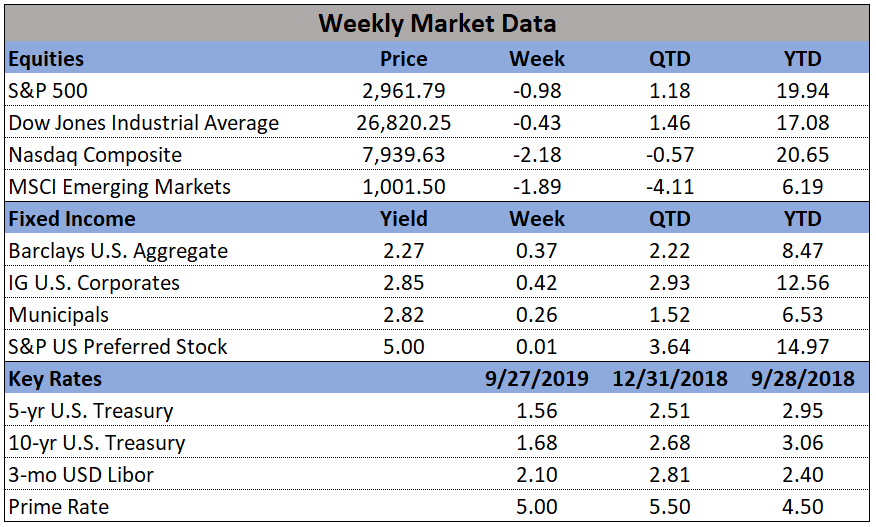In the markets:
U.S. Markets: Following a spike in the price of oil due to an attack on a Saudi Arabian oil facility, equities finished the week modestly lower. The Dow Jones Industrial Average gave up 284 points, ending the week at 26,935—a decline of -1.1%. The technology-heavy NASDAQ Composite retreated -0.7% to 8,117. By market cap the large cap S&P 500 fell -0.5%, while the S&P 400 midcap index and small cap Russell 2000 finished down -0.9% and -1.2%, respectively. The dramatic outperformance by small caps last week did not persist into this week.
International Markets: International markets were mixed for the week. Canada’s TSX rose for a fourth consecutive week, adding 1.3%, while the United Kingdom’s FTSE declined -0.3%. On Europe’s mainland, France’s CAC 40 added 0.6% while Germany’s DAX finished essentially flat. In Asia, China’s Shanghai Composite declined -0.8% and Japan’s Nikkei finished up 0.4%--its third straight gain. As grouped by Morgan Stanley Capital International, developed markets finished down -0.6%, while emerging markets fell -1.5%.
Commodities: Precious metals rose for the first week in four, reflecting the weakness in the equities markets. Gold rose $15.60 an ounce ending the week at $1515.10—a gain of 1%. Silver added 1.6% and closed at $17.85 an ounce. Oil rallied following the attack on Saudi Arabia’s oil facility, rising 5.9% to $58.09 per barrel. The industrial metal copper, sometimes called “Dr. Copper” due to its value as a barometer of world economic health, finished the week down -3.5%.
U.S. Economic News: The number of Americans applying for new unemployment benefits inched higher last week, the Labor Department reported. Initial jobless claims rose by 2,000 to 208,000. Economists had estimated claims would come in at 215,000. The monthly moving average of claims, smoothed to iron out the weekly volatility, fell by a smaller 750 to 212,250. Claims remain far below the key 300,000 threshold that economists use to denote a “balanced” jobs market. Jim O’Sullivan, chief U.S. economist at High Frequency Economics wrote in a note to clients, “Claims remain low, consistent with a still-solid trend in employment growth. While net employment growth depends on gross hiring as well as the pace of layoffs, and the trend in payrolls gains appears to have moderated a bit - due to reduced hiring rather than increased firing - major weakening in employment growth is invariably associated with an uptrend in claims.”
The Commerce Department said construction of new housing surged 12% last month to its fastest pace in more than a year. Housing starts increased at an annual rate of 1.36 million in August, up from a revised 1.22 million in July. Economists had expected a 1.26 million rate for starts. The reading was the fastest pace for starts since 2007. In addition, in a positive sign for future building activity, permits to build additional homes rose 8% to a seasonally-adjusted annual pace of 1.42 million. The details of the report revealed that the jump was driven predominantly by the construction of multifamily properties such as apartments and condominiums. The rate of construction of buildings with five or more units jumped 30% to an annual rate of 424,000. Single-family home starts were up a more modest 4%. Nevertheless, August was the strongest month for single-family starts since January.
Confidence among the nation’s home builders rose slightly, despite overall concerns about the nation’s economy. The National Association of Home Builders (NAHB) reported its monthly confidence index increased one point to 68 this month—matching its highest reading in a year. Readings over 50 signify that confidence is improving, while figures below show sentiment is deteriorating. In the details of the NAHB report, the gauge of current single-family home sales increased two points to 75, also its highest reading in a year, while the sub-index that tracks expectations for future sales dropped one point to 70. The gauge for buyer traffic remained unchanged at 50. Regionally, home-builder sentiment improved markedly in the Northeast, South and West and remained even in the Midwest.
The Conference Board reported its Leading Economic Index (LEI) remained unchanged in August at 112.1. The reading follows a 0.4% increase in July and no change in June. Ataman Ozyildirim, Senior Director of Economic Research at The Conference Board stated, “The US LEI remained unchanged in August, following a large increase in July. Housing permits and the Leading Credit Index offset the weakness in the index from the manufacturing sector and the interest rate spread. The recent trends in the LEI are consistent with a slow but still expanding economy, which has been primarily driven by strong consumer spending and robust job growth."
Manufacturing activity in the New York region weakened significantly this month, but remained above zero. The New York Federal Reserve reported its Empire State Manufacturing index fell 2.8 points to 2.0 in September, missing expectations for an unchanged reading. In the details, the new-orders index fell 3.2 points to 3.5, while the shipments index fell 3.5 points to 5.8—its lowest level in almost three years. In addition, unfilled orders remained negative for a fourth consecutive month. The index that measures how manufacturers feel about the future plunged 12 points to 13.7. The one bright spot in the report was employment, which rebounded out of negative territory. Some analysts remain optimistic that the weakness in manufacturing may have run its course. Thomas Simons, senior economist at Jefferies believes so: “The sector has suffered from the uncertainty caused by the trade war, and there’s been a significant loss in momentum in business investment, but the pullback has now played out to the point where we expect to see data that suggests the sector is drifting sideways.”
In the city of Brotherly Love, manufacturing activity weakened but remained in positive territory according to the Philadelphia Fed. The Philadelphia Federal Reserve’s manufacturing index fell -4.8 points to 12.0 in September. Economists had expected a reading of 10.0. In the details, the index for general activity and new orders fell, while the indexes for shipments and employments increased. The survey’s future general activity index moderated but continues to suggest growth over the next six months. In a note to clients, Joshua Shapiro, Chief U.S. Economist at Maria Fiorini Ramirez wrote, “The fact that the new orders measure has now posted six consecutive good results after weakening significantly in February and March is an encouraging sign, and suggests that the factory sector, while suffering from an inventory correction, weak demand abroad and the effects of tariffs, has not fallen off a cliff.”
As was widely expected by market participants, the Federal Reserve lowered its key interest rate target range by a quarter point to 1.75-2%. Furthermore, in its statement the Fed expressed an openness to even more easing. This week’s cut was the second in two months. Three of the seven members dissented from the quarter-point cut. Two voted against the move because they felt rates should be held steady, and one because he wanted a more aggressive half-point cut. Seven Fed officials said they believed there would be one more rate cut this year. In explaining the decision Powell told reporters at a briefing, “Our business contacts around the country have been telling us that uncertainty is weighing on U.S. investment and exports.” Powell said the Fed sees a favorable economic outlook, but said there were risks. “If the economy does turn down, then a more extensive sequence of rate cuts could be appropriate,” he said.








